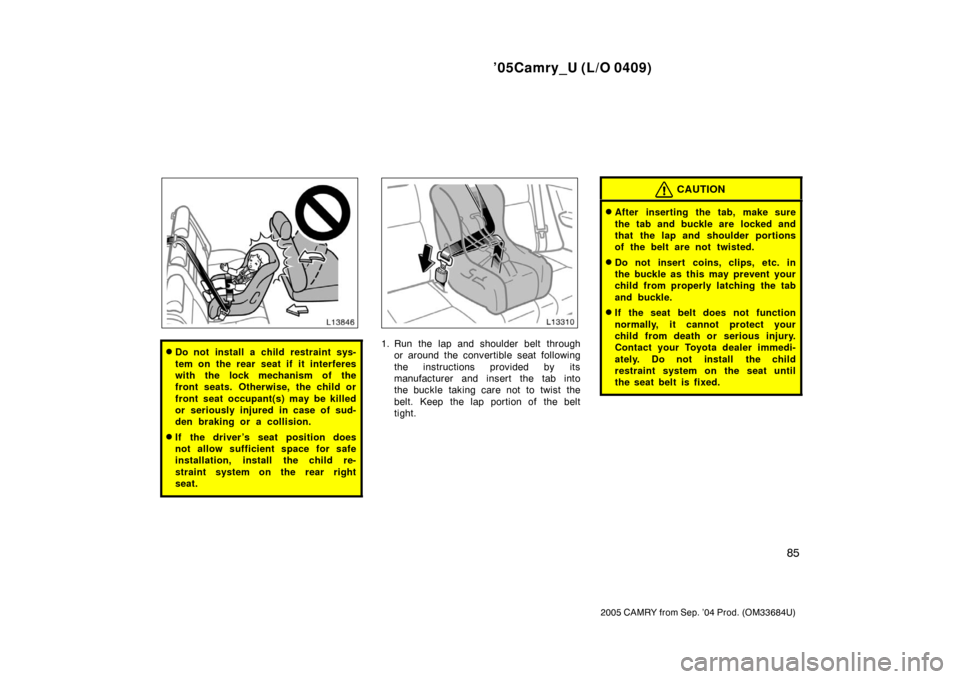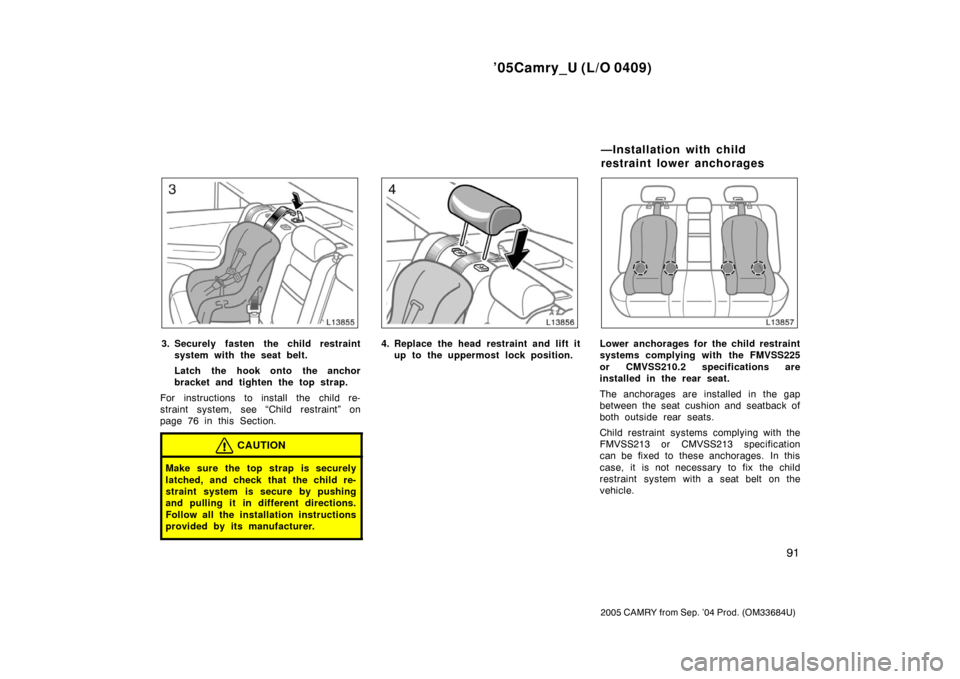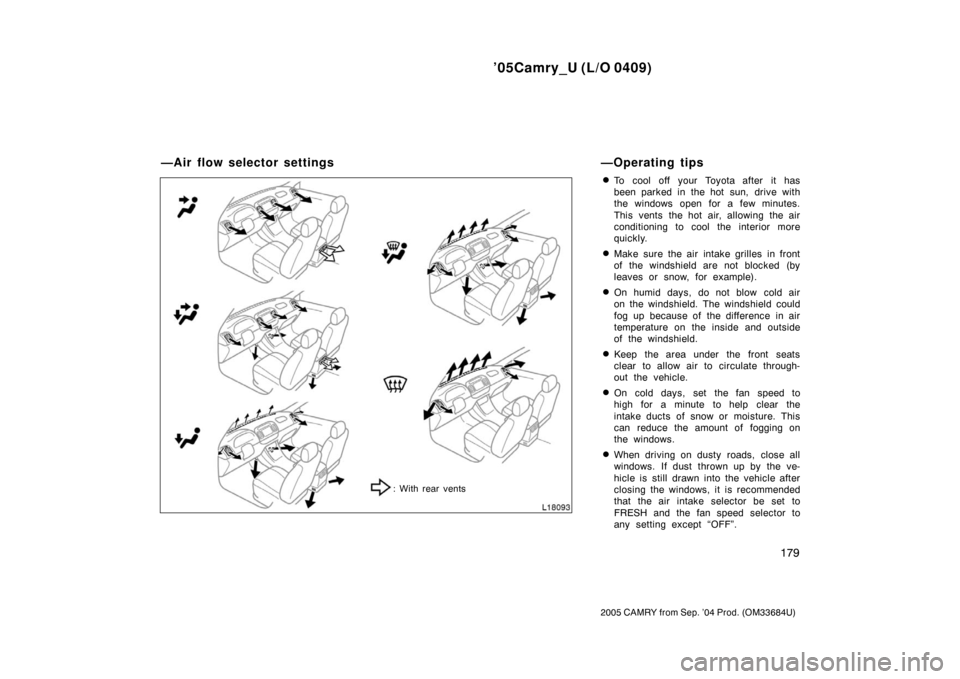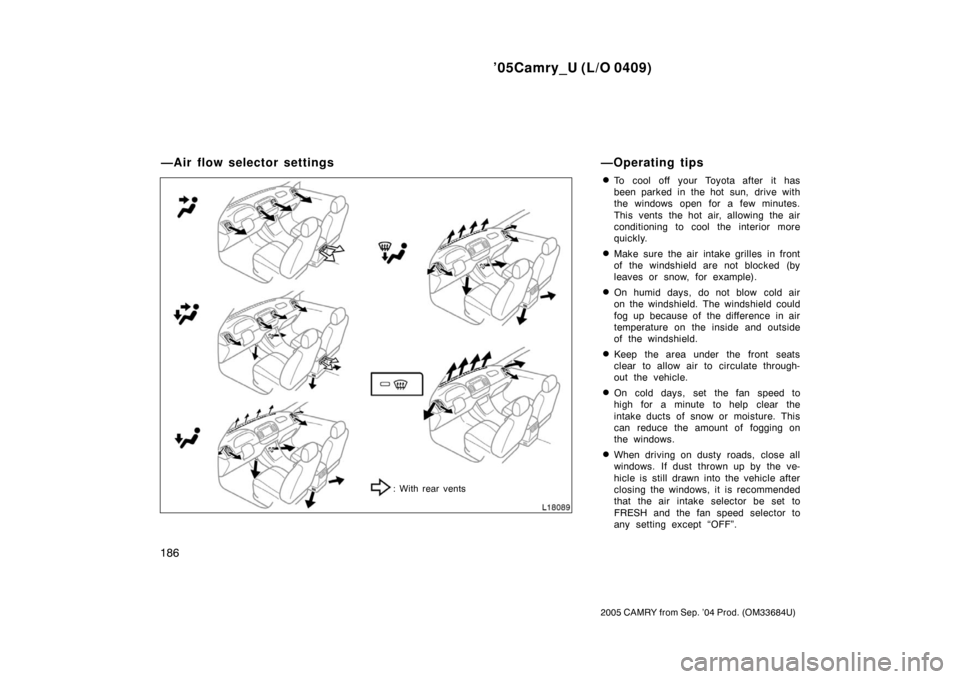Page 93 of 352

’05Camry_U (L/O 0409)
85
2005 CAMRY from Sep. ’04 Prod. (OM33684U)
�Do not install a child restraint sys-
tem on the rear seat if it interferes
with the lock mechanism of the
front seats. Otherwise, the child or
front seat occupant(s) may be killed
or seriously injured in case of sud-
den braking or a collision.
�If the driver ’s seat position does
not allow sufficient space for safe
installation, install the child re-
straint system on the rear right
seat.
1. Run the lap and shoulder belt throughor around the convertible seat following
the instructions provided by its
manufacturer and insert the tab into
the buckle taking care not to twist the
belt. Keep the lap portion of the belt
tight.
CAUTION
�After inserting the tab, make sure
the tab and buckle are locked and
that the lap and shoulder portions
of the belt are not twisted.
�Do not insert coins, clips, etc. in
the buckle as this may prevent your
child from properly latching the tab
and buckle.
�If the seat belt does not function
normally, it cannot protect your
child from death or serious injury.
Contact your Toyota dealer immedi-
ately. Do not install the child
restraint system on the seat until
the seat belt is fixed.
Page 99 of 352

’05Camry_U (L/O 0409)
91
2005 CAMRY from Sep. ’04 Prod. (OM33684U)
3. Securely fasten the child restraintsystem with the seat belt.
Latch the hook onto the anchor
bracket and tighten the top strap.
For instructions to install the child re-
straint system, see “Child restraint” on
page 76 in this Section.
CAUTION
Make sure the top strap is securely
latched, and check that the child re-
straint system is secure by pushing
and pulling it in different directions.
Follow all the installation instructions
provided by its manufacturer.
4. Replace the head restraint and lift it up to the uppermost lock position.Lower anchorages for the child restraint
systems complying with the FMVSS225
or CMVSS210.2 specifications are
installed in the rear seat.
The anchorages are installed in the gap
between the seat cushion and seatback of
both outside rear seats.
Child restraint systems complying with the
FMVSS213 or CMVSS213 specification
can be fixed to these anchorages. In this
case, it is not necessary to fix the child
restraint system with a seat belt on the
vehicle.
—Installation with child
restraint lower anchorages
Page 101 of 352
’05Camry_U (L/O 0409)
93
2005 CAMRY from Sep. ’04 Prod. (OM33684U)
For installation details, refer to the instruc-
tion manual equipped with each product.
CAUTION
�When using the lower anchorages
for the child restraint system, be
sure that there are no irregular ob-
jects around the anchorages or that
the seat belt is not caught.
�Push and pull the child restraint
system in different directions to be
sure it is secure. Follow all the
installation instructions provided by
its manufacturer.
�Do not install a child restraint sys-
tem on the rear seat if it interferes
with the lock mechanism of the
front seats. Otherwise, the child or
front seat occupant(s) may be killed
or seriously injured in case of sud-
den braking or a collision.
Page 105 of 352

’05Camry_U (L/O 0409)
97
2005 CAMRY from Sep. ’04 Prod. (OM33684U)
When you set your driving position:1. Set the parking brake firmly.
2. Move the accelerator and brake pedals to the front most position.
3. Adjust the seat position and steering wheel angle properly. (See “Front
seats” on page 40 in Section 1 −3 and
“Tilt steering wheel” on page 96 in
this Section.)
4. Move the pedals toward you until you can fully depress the brake pedal.
5. After adjusting, depress the pedals a few times to get used to the feel.
CAUTION
�Never put your foot on the acceler-
ator pedal while the pedals are
moving. It may cause racing of the
engine or sudden acceleration.
�Make sure that you can fully de-
press the brake pedal before driv-
ing. Otherwise, you may not be able
to hold down the brake pedal firmly
in an emergency stop.
Adjust the mirror so that you can just
see the side of your vehicle in the mir-
ror.
Be careful when judging the size or dis-
tance of any object seen in the outside
rear view mirror on the passenger ’s side
because it is a convex mirror. Any object
seen in a convex mirror will look smaller
and farther away than when seen in a flat
mirror.
On some models, when you push the rear
window defogger switch, the heater panels
in the outside rear view mirrors will quick-
ly clear the mirror surface. (See “Rear
window and outside rear view mirror de-
foggers” on page 111 in Section 1 −5.)
CAUTION
�Do not adjust the mirror while the
vehicle is moving. Doing so may
cause the driver to mishandle the
vehicle and an accident may occur
resulting in death or serious inju-
ries.
�Since the mirror surfaces can get
hot, do not touch them when the
defogger switch is on.
NOTICE
The outside rear view mirrors are
fixed in place. Do not try to fold the
mirrors. It may damage the mirrors.
Outside rear view mirrors—
Page 187 of 352

’05Camry_U (L/O 0409)
179
2005 CAMRY from Sep. ’04 Prod. (OM33684U)
�To cool off your Toyota after it has
been parked in the hot sun, drive with
the windows open for a few minutes.
This vents the hot air, allowing the air
conditioning to cool the interior more
quickly.
�Make sure the air intake grilles in front
of the windshield are not blocked (by
leaves or snow, for example).
�On humid days, do not blow cold air
on the windshield. The windshield could
fog up because of the difference in air
temperature on the inside and outside
of the windshield.
�Keep the area under the front seats
clear to allow air to circulate through-
out the vehicle.
�On cold days, set the fan speed to
high for a minute to help clear the
intake ducts of snow or moisture. This
can reduce the amount of fogging on
the windows.
�When driving on dusty roads, close all
windows. If dust thrown up by the ve-
hicle is still drawn into the vehicle after
closing the windows, it is recommended
that the air intake selector be set to
FRESH and the fan speed selector to
any setting except “OFF”.
—Air flow selector settings
: With rear vents
—Operating tips
Page 194 of 352

’05Camry_U (L/O 0409)
186
2005 CAMRY from Sep. ’04 Prod. (OM33684U)
�To cool off your Toyota after it has
been parked in the hot sun, drive with
the windows open for a few minutes.
This vents the hot air, allowing the air
conditioning to cool the interior more
quickly.
�Make sure the air intake grilles in front
of the windshield are not blocked (by
leaves or snow, for example).
�On humid days, do not blow cold air
on the windshield. The windshield could
fog up because of the difference in air
temperature on the inside and outside
of the windshield.
�Keep the area under the front seats
clear to allow air to circulate through-
out the vehicle.
�On cold days, set the fan speed to
high for a minute to help clear the
intake ducts of snow or moisture. This
can reduce the amount of fogging on
the windows.
�When driving on dusty roads, close all
windows. If dust thrown up by the ve-
hicle is still drawn into the vehicle after
closing the windows, it is recommended
that the air intake selector be set to
FRESH and the fan speed selector to
any setting except “OFF”.
—Air flow selector settings
: With rear vents
—Operating tips
Page 243 of 352

’05Camry_U (L/O 0409)
235
2005 CAMRY from Sep. ’04 Prod. (OM33684U)
Ti r e relat ed ter mMeaning
Accessory weight
the combined weight (in excess of those standard items which may be
replaced) of automatic transmission, power steering, power brakes, power
windows, power seats, radio, and heater, to the extent that these items
are available as factory−installed equipment (whether installed or not)
Cold tire inflation pressure
tire inflation pressure when the vehicle has been parked for at least 3
hours or more, or it has not been driven more than 1.5 km or 1 mile
under that condition
Curb weight
the weight of a motor vehicle wi th standard equipment including the
maximum capacity of fuel, oil, and coolant, and, if so equipped, air
conditioning and additional weight optional engine
Intended outboard sidewall
(A) the sidewall that contains a whitewall, bears white lettering or bears manufacturer, brand, and/or model name molding that is higher or
deeper than the same molding on th e other sidewall of the tire, or
(B) the outward facing sidewall of an asymmetrical tire that has a particular side that must always face outward when mounted on a vehicle
Maximum inflation pressurethe maximum cold inflation pressure to which a tire may be inflated and it
is shown on the sidewall of the tire
Maximum loaded vehicle weight
t he sum of —
(a) curb weight;
(b) accessory weight;
(c) vehicle capacity weight; and
(d) production options weight
—Glossary of tire terminology
Page 247 of 352

’05Camry_U (L/O 0409)
239
2005 CAMRY from Sep. ’04 Prod. (OM33684U)
CAUTION
�To prevent cargo and l uggage
from sliding forward during
braking, do not stack anything
in the enlarged trunk. Keep car-
go and luggage low, as close
to the floor as possible.
� Never allow anyone to ride in
the enlarged trunk. It is not de-
signed for passengers. They
should ride in their seats with
their seat belts properly fas-
tened. Otherwise, they are
much more likely to suffer seri-
ous bodily injury, in the event
of sudden braking or a colli-
sion.
� Do not place anything on the
package tray behind the rear
seatback. Such items may be
thrown about and possibly in-
jure people in the vehicle dur-
ing sudden braking or an acci-
dent.
�Do not drive with objects left
on top of the instrument panel.
They may interfere with the
driver’s field of view. Or they
may move during sharp vehicle
acceleration or turning, and im-
pair the driver’s control of the
vehicle. In an accident they
may injure the vehicle occu-
pants.Cargo capacity depends on the to-
tal weight of the occupants.
(Cargo capacity) = (Total load capac-
ity) – (Total weight of occupants)
STEPS FOR DETERMINING
CORRECT LOAD LIMIT
1. Locate the statement “The com- bined weight of occupants and
cargo should never exceed XXX
pounds” on your vehicle’s placard.
2. Determine the combined weight of the driver and passengers that will
be riding in your vehicle.
3. Subtract the combined weight of the driver and passengers from
XXX kilograms or XXX pounds.
—Capacity and distribution